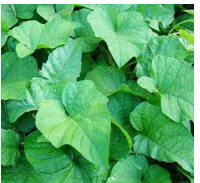 |
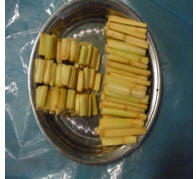 |
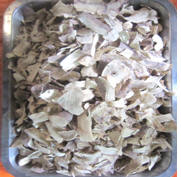 |
| Photo 1: Operculina turpethum | Photo 2: Sugarcane stalk residue | Photo 3: Dried sweet potato waste |
| Back to contents |
Effect of different sizes of sugarcane stalk residue in the basal diet with Operculina turpethum supplement on feed utilization, nutrient digestibility and growth rate of crossbred rabbits
Nguyen Thi Kim Dong and Nguyen Van Thu
Cantho University, Vietnam
ntkdong@ctu.edu.vn
An experiment was carried out at the experimental farm and laboratory of Can Tho University to evaluate feed utilization, nutrient digestibility and growth rate of Crossbred rabbits. It was a factorial design in which the first factor was length of sugarcane stalk residue (SSR) (3 and 10 cm length) fed ad-libitum, and second factor was different supplement of Operculina turpethum (OT) (0, 100, 200 and 300g/rabbit/day) with three replications and 4 rabbits per experimental unit. The results show that the intakes of sugarcane stalk residue were slightly higher (P>0.05) for rabbits fed 3cm length and gradually decreased with increasing supplement of OT in the diets (P<0.05), while OT intakes were remarkably increased (P<0.05). The total DM, CP, EE and ME intakes were higher for rabbits given sugarcane stalk residue at 3cm length (P<0.05) and when increasing the levels of OT supplement (P<0.05). The digestibility coefficients of DM and CP were higher for animals offered 3cm length sugarcane stalk residue (P<0.05), and NDF values were clearly improved with increasing OT supplement in the diets (P<0.05). The higher nitrogen intake and retention were found for rabbits fed 3cm sugarcane residue (P<0.05) and supplemented 300g OT/rabbit/day. The daily gain and final live weight were significantly higher for rabbits fed 3cm length sugarcane stalk residue and supplemented 300g OT per animal per day (P<0.05).
It was concluded the rabbits fed 3cm length sugarcane stalk residue and supplemented 300g OT per animal per day in the diet had better growth rate and gave higher economic returns.
Key words: Daily weight gain, nutrient intake, nitrogen retention, economic returns
Para grass (Brachiaria mutica) is popuparly fed ruminants and rabbits in the Mekong delta (MD) of Vietnam due to the well growth and good nutrient contents, particularly it supplies the fiber source. While Operculina turpethum is used for offering protein in the diets. Also sugarcane talks have a high sugar content, which could be used for supplying energy source to mono-gastric animals (Preston and Leng, 1987). Nguyen Quang Suc et al (1995) concluded that sugarcane is an important source of fiber and energy for the rabbit. Peeled sugarcane stalk, supplemented with protein-rich feeds (soyabean seed and Canada bean foliage), could replace concentrates and grass for lactating and fattening rabbits. In an early trial in Mauritius, coarsely chopped sugarcane was successfully used to replace one half the balanced concentrate feed ration with no consequent drop in performance. In a complementary trial, the same authors found that, fed ad lib, rabbits chose to replace up to 40 percent of their balanced concentrate feed with chopped sugarcane (Lebas et al., 1997). In the MD sugarcane production has been developed well with 48,000 ha and 3.2 million tons in production year 2010-2011 (SGGP, 2011). Sugarcane stalks are popularly pressed to make fresh juice for human consumption, besides the main product of sugar. In the process of making the juice the lower parts of the stalks with more bud-eyes become the residues, however the studies on their utilization as animal feed resources has been limited. Therefore, this study aimed to determine nutrient utilization and performance of growing rabbits based on sugarcane stalk residue associated with Operculina turpethum supplementation for improving the production and farmers’ income.
Materials and Methods
Experimenta1 Feeding trial
Animals and experimental design
The experiment was carried out in Experimental farm in Cantho City. Ninety six young crossbred rabbits (local x improved breeds) at 6 weeks of age with similar live weight around 712 - 750g were arranged in a factorial design with 2 factors. The first factor was length of sugarcane stalk residue (3 and 10 cm length) fed ad-libitum, while second one was supplementation levels of Operculina turpethum (OT) (0, 100, 200 and 300g/rabbit/day) with three replications and 4 rabbits (sexual balance) per experimental unit. Para grass, soya waste and dried sweet potato waste were also given with the same amount to all dietary treatments to provide protein and energy. The experimental period was 10 weeks.
 |
 |
 |
| Photo 1: Operculina turpethum | Photo 2: Sugarcane stalk residue | Photo 3: Dried sweet potato waste |
Feeds, feeding and management
Operculina turpethum (OT) and Para grass were daily collected surrounding the farm and soya waste was daily bought from the soya meal factory. The sugarcane stalk residue (SSR) was a lower part left of sugarcane tree after selection a good part to make sugarcane juice for human. Before feeding, the SSR was cut to small pieces of 3cm and 10 cm length.
Dried sweet potato waste was bought in an occasion used throughout the experiment. The animals were fed three times a day at 8:00h, 14:00h and 18:00h. OT and SSR were offered and recorded daily. Fresh water was available for all rabbits almost all day and night time. The refusals and spillage were daily collected and weighed in the morning to calculate the feed intake. The animals were vaccinated to prevent some diseases, especially rabbit Hemorrhagic, parasite and other common diseases.
Measurements
The feeds and refusals were taken for analyses of DM, OM, CP, EE, Ash and NDF following procedure of AOAC (1990) and Van Soest et al. (1991). At the beginning of the experiment, four rabbits per experimental unit were weighed individually weekly. Daily feed intakes, growth rate, and feed conversion ratios were measured and calculated. The economic analysis was also done among the treatments.
Experiment 2: Digestibility trial
Animals and experimental design
The second experimental design was similar to that of the feeding trial; however, two rabbits at 12 weeks of age were used per experimental unit. The animals had two weeks for adaptation and one week for fecal collection. Feeds and refusals were daily measured. Urine was also collected for nitrogen analysis to calculate the nitrogen retention. DM, CP, EE and NDF digestibility were employed according Mc Donald et al (2002).
Statistical analysis
The data from both experiments were analyzed by analysis of variance using the ANOVA of General Linear Model of Minitab Reference Manual Release 13.21 (Minitab, 2000). Economic analyses were done using current prices in Vietnamese Dong (VND) to compare differences of income and the feed cost in different treatments.
Results and discussion
Feed characteristics
Chemical composition of feed ingredients of rabbit is presented in Table 1.
|
Table 1: Chemical composition of feed ingredients in feeding experiment (%, DM) |
|||||||
|
Feed ingredient |
DM |
OM |
CP |
EE |
NDF |
Ash |
ME, MJ/kg DM |
|
Operculina turpethum |
10.3 |
98.2 |
15.4 |
6.50 |
35.2 |
1.80 |
10.7 |
|
Sugarcane stalk residue |
25.9 |
97.5 |
3.60 |
4.44 |
22.0 |
2.58 |
9.20 |
|
Para grass |
18.7 |
89.3 |
12.9 |
3.46 |
57.6 |
10.7 |
9.21 |
|
Soya waste |
13.6 |
97.3 |
20.0 |
10.0 |
35.3 |
2.70 |
11.3 |
|
Dried sweet potato |
77.8 |
97.1 |
5.06 |
1.05 |
24.7 |
2.90 |
13.5 |
|
Extracted soybean |
90.2 |
91.0 |
43.2 |
2.50 |
27.5 |
9.00 |
11.4 |
|
DM: dry matter, OM: organic matter, CP: crude protein, EE: ether extract, NDF: neutral detergent fibre, ME: metabolizable energy (Maertens et al., 2002) |
|||||||
Operculina turpethum (OT) had higher CP and EE contents, but lower NDF component as compared to those of Para grass (PG) (Table 1), while sugarcane stalk residue (SSR) with the lowest CP value. The DM and CP contents of OT in our experiment are similar to the values (11.2% DM and 15.2% CP) reported by Pham Duc Thang (2008). Dried sweet potato waste had higher ME concentration as compared to other feeds to provide energy for the rabbits.
Feed and
nutrient intakes in the feeding experiment
Daily
intakes of feeds and nutrients of rabbits in feeding experiment are shown in
Table 2.
|
Table 2: Daily intakes of feeds and nutrients of growing rabbits in feeding experiment (g/rabbit/day) |
||||||||||
|
Item |
SSR length (SSRL) |
OT level (OTL) |
SE/P |
|||||||
|
3cm |
10cm |
OT0 |
OT100 |
OT200 |
OT300 |
SSRL |
OTL |
|||
|
OT |
15.5 |
15.5 |
- |
10.3a |
20.6b |
30.9c |
- |
-/0.001 |
||
|
SSR |
17.7 |
16.0 |
22.0a |
17.6b |
14.1bc |
13.7c |
0.66/0.09 |
0.94/0.001 |
||
|
DM |
62.8 |
61.2 |
57.4a |
61.3b |
63.0c |
66.2d |
0.23/0.001 |
0.32/0.001 |
|
|
|
OM |
59.0 |
57.5 |
54.8a |
58.0b |
59.0b |
61.3c |
0.22/0.001 |
0.32/0.001 |
|
|
|
CP |
7.66 |
7.47 |
6.92a |
7.49b |
7.75bc |
8.09c |
0.06/0.05 |
0.87/0.001 |
|
|
|
EE |
2.60 |
2.57 |
2.09a |
2.41b |
2.76c |
3.10d |
0.02/0.19 |
0.02/0.001 |
|
|
|
NDF |
18.4 |
18.1 |
15.6a |
17.5b |
19.0c |
20.8d |
0.09/0.06 |
0.13/0.001 |
|
|
|
ME(MJ/rabbit) |
0.69 |
0.68 |
0.63a |
0.67b |
0.70c |
0.74d |
0.01/0.001 |
0.002/0.001 |
|
|
|
OT: Operculina turpethum, SSR: sugarcane stalk residue. OT0, OT100, OT200, OT300: Operculina turpethum supplemented in diets at levels of 0, 100, 200 and 300g/rabbit/ day |
||||||||||
Daily intake of Operculina turpethum (OT) was similar between two sizes of SSR length (P>0.05). However there was considerably increase of OT intakes corresponding with increasing levels of OT in diets (P<0.05), while SSR intake significantly decreased (P<0.05). Rabbits fed 3cm length sugarcane stalk residue (SSR) tended to have higher intake, but being not significantly different (P>0.05) (Table 2). The total daily intakes of DM, OM, CP and ME were higher for animals fed 3cm length SSR (P<0.05), as a result of short SSR pieces make the rabbits rodent efficiently. The intakes of DM, OM, CP, EE, NDF and ME increased with increasing levels of OT in the diets, reaching the highest values for the OT300 diet (P<0.05), possibly due to graded supplements of OT in the diets. The daily DM intakes in a present study are in agreement with the results (57.5-62.7gDM/rabbit), but being lower in CP intakes (10.4- 11.0gCP/rabbit) reported by Ly Hoa Nguyet (2011).
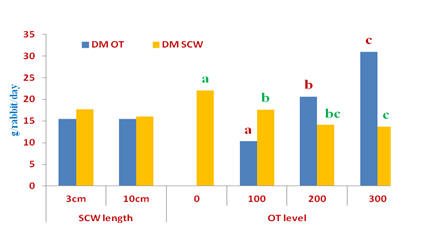 |
|
|
Figure 1: Daily intakes of OT and SSR (g DM/day) |
Growth rate, feed conversion ratio and economic analysis in feeding experiment
The results of daily weight gain, final weight and economic analysis of rabbits are shown in Table 3.
|
Table 3: Daily weight gain, final live weight (g/rabbit) and economic returns (VND) of growing rabbits |
|
|||||||||||
|
Item |
SSR length (SSRL) |
OT level (OTL) |
SE/P |
|
||||||||
|
3 cm |
10 cm |
OT0 |
OT100 |
OT200 |
OT300 |
SSRL |
OTL |
|
||||
|
Initial weight |
740 |
738 |
741 |
742 |
736 |
736 |
3.18/0.57 |
4.50/0.70 |
|
|||
|
Final weight |
2078 |
1964 |
1930a |
2005b |
2032b |
2117c |
10.1/0.001 |
14.3/0.001 |
|
|||
|
Daily weight gain |
19.1 |
17.5 |
17.0a |
18.0b |
18.5b |
19.7c |
0.14/0.001 |
0.19/0.001 |
|
|||
|
FCR |
3.29 |
3.49 |
3.38 |
3.40 |
3.41 |
3.37 |
0.02/0.001 |
0.03/0.76 |
|
|||
|
Feed cost |
22,750 |
23,170 |
20,650 |
22,050 |
23,450 |
29,050 |
||||||
|
Total expense |
92,750 |
93,170 |
90,650 |
92,050 |
93,450 |
99,050 |
||||||
|
Total income |
135,070 |
127,660 |
125,450 |
130,325 |
132,080 |
137,540 |
||||||
|
Profit |
42,320 |
34,490 |
34,800 |
38,275 |
38,630 |
38,490 |
||||||
|
OT: Operculina turpethum, SSR: sugarcane stalk residue. Means with different letters within the same rows are significantly different at the 5% level. |
|
|||||||||||
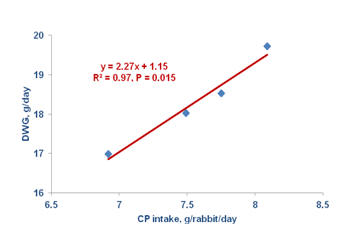 |
| Figure 2: Relationship between CP intake and DG of growing rabbits |
The economic analysis was done and showed that the feed cost and total expense were lower for rabbits fed 3cm length SSR and for the OT0 diet. However, the higher income was found in the short SSR length and the OT200, OT300 diets, resulting in more benefits in these diets. The results indicated that the promising diets giving better economic returns for rabbit production could be supplemented Operculina turpethum at levels of 200-300 g/rabbit/day. There were no significantly different interactions between two factors of length of sugarcane stalk residue and levels of Operculina turpethum in all criteria of the feeding experiment (P>0.05).
Experiment 2: Digestibility trial
Feed characteristics
|
Table 4: Chemical composition of feed ingredients in digestibility experiment. (% DM basis) |
||||||
|
Feed ingredient |
DM |
OM |
CP |
NDF |
Ash |
ME, MJ/kg DM |
|
Operculina turpethum |
11.0 |
90.2 |
15.0 |
32.5 |
9.80 |
10.7 |
|
Sugarcane stalk residue |
25.9 |
97.5 |
3.43 |
22.0 |
2.50 |
9.20 |
|
Para grass |
18.5 |
89.3 |
12.9 |
57.6 |
10.7 |
8.25 |
|
Soya waste |
11.2 |
95.1 |
20.8 |
33.9 |
4.90 |
11.3 |
|
Dried sweet potato |
94.5 |
97.3 |
2.68 |
14.9 |
2.70 |
13.4 |
|
Extracted soybean |
90.2 |
91.0 |
43.2 |
27.5 |
9.00 |
11.4 |
|
DM: dry matter, OM: organic matter, CP: crude protein, NDF: neutral detergent fibre, ME: metabolizable energy (Maertens et al., 2002) |
||||||
Daily intakes of feed and nutrients of growing rabbits in digestibility experiment
Daily intakes of feed and nutrients of rabbits in digestibility trial are presented in Table 5
|
Table 5: Daily intakes of feed and nutrients of growing rabbits in digestibility experiment (g DM/rabbit) |
||||||||
|
Item |
SSR length (SSRL) |
OT level (OTL) |
SE/P |
|||||
|
3 cm |
10 cm |
OT0 |
OT100 |
OT200 |
OT300 |
SSRL |
OTL |
|
|
DM |
75.4 |
72.5 |
64.20a |
68.6a |
77.1b |
85.9b |
0.80/0.018 |
1.13/0.001 |
|
OM |
71.1 |
68.2 |
61.3a |
64.8a |
72.4b |
80.2b |
0.79/0.018 |
1.12/0/001 |
|
CP |
9.45 |
8.92 |
7.53a |
8.98b |
9.35c |
10.9d |
0.04/0.001 |
0.06/0.001 |
|
NDF |
22.3 |
21.9 |
18.4a |
20.4b |
23.1c |
26.4d |
0.17/0.09 |
0.23/0.001 |
|
ME |
0.80 |
0.78 |
0.70a |
0.73a |
0.80b |
0.92b |
0.008/0.05 |
0.01/0.001 |
|
OT: Operculina turpethum, SSR: sugarcane stalk residue. OT0, OT100, OT200, OT300: Operculina turpethum supplemented in diets at levels of 0, 100, 200 and 300g/rabbit/ day. Means with different letters within the same rows are significantly different at the 5% level |
||||||||
Daily intakes of DM and most of nutrients such as OM, CP, NDF and ME of the rabbits between two factors were slightly higher than those obtained in the feeding trial, may be due to data recorded in one week of the 12 week old rabbits in digestibility experiment.
Apparent digestibility of dietary nutrients, nitrogen retention of growing rabbits are shown in Table 6.
|
Table 6: Apparent digestibility (%) of dietary nutrients and nitrogen retention of growing rabbits |
||||||||
|
Item |
SSR length (SSRL) |
OT level (OTL) |
SE/P |
|||||
|
3 cm |
10 cm |
OT0 |
OT100 |
OT200 |
OT300 |
SSRL |
OTL |
|
|
DMD |
71.9 |
68.5 |
67.5 |
69.1 |
70.4 |
73.7 |
1.17/0.054 |
1.66/0.09 |
|
OMD |
73.0 |
69.6 |
68.8 |
70.5 |
71.3 |
74.7 |
1.12/0.046 |
1.58/0.10 |
|
CPD |
79.0 |
73.8 |
74.6 |
75.5 |
77.4 |
78.2 |
1.22/0.008 |
1.73/0.45 |
|
NDFD |
40.8 |
34.1 |
25.8a |
35.4ab |
40.4ab |
48.3b |
2.61/0.09 |
3.70/0.004 |
|
Nitrogen balance (g/kg W0,75) |
||||||||
|
N intake |
1.16 |
0.94 |
0.90a |
1.03ab |
1.09b |
1.19b |
0.03/0.001 |
0.04/0.002 |
|
N retention |
0.86 |
0.64 |
0.65a |
0.75ab |
0.80b |
0.79b |
0.02/0.001 |
0.03/0.032 |
|
OT: Operculina turpethum, SSR: sugarcane stalk residue. OT0, OT100, OT200, OT300: Operculina turpethum supplemented in diets at levels of 0, 100, 200 and 300g/rabbit/ day. Means with different letters within the same rows are significantly different at the 5% level |
||||||||
The apparent digestibility coefficients of DM, OM and CP were significantly higher (P<0.05) in the 3cm length SSR. These values were improved when increasing OT supplements in the diets, but being not significantly different (P>0.05) (Table 6). Our results are also in agreement with the findings that the digestibility indices of DM and CP were improved with increasing water spinach levels offered in the diets (Samkol et al., 2006b). The obtained DM and CP digestibility values are similar to those (65.4 to 75 %DM and 74.3 to 80.6 %CP) of studies reported by Akinfala et al (2003) and Nguyen Thanh Tung (2012), respectively. However, the results in our experiment are lower than those (80.5-85.4 % CPD) found by Huynh Thu Thao (2011).
The results indicate that there was significant difference in both the nitrogen intake and nitrogen retention between two factors (P<0.05), this probable explanation is different CP intakes in dietary treatments caused by graded OT supplementation. The findings of nitrogen intake and nitrogen retention in this experiment are consisted with data of 0.57- 0.74 g/kg W0,75 stated by Duong Thi Bich Loan (2010). In the present experiment there were no significantly different interactions between two factors of length of sugarcane stalk residue and levels of Operculina turpethum in all criteria of the digestibility trial (P>0.05).
Conclusions
Fund support of this work from MEKARN Project financed by Sida/Sarec gratefully acknowledged. The authors would like to thank Dr. TR Preston for his valuable advices and the Department of Animal Sciences, Faculty of Agriculture & Applied Biology of Cantho University for infrastructure supports.
Akinfala E O, Matanmi O and Aderibigbe AO 2003 Preliminary studies on the response of weaned rabbits to whole cassava plant meal basal diets in the humid tropics. Livestock Research for Rural Development. Vol. 15 (4):http://www.lrrd.org/lrrd/4/akĩn.htm
AOAC 1990 Official methods of analysis (15th edition). Washington, DC. Volume 1: 69-90
Duong Thi Bich Loan 2010 Effect of different energy feed source supplementation on growth rate, nutrient digestibility and economic returns of growing Crossbred rabbits in the Mekong Delta. MSc Thesis. Faculty of Agriculture and Applied Biology, Cantho University
Huynh Thu Thao 2011 Effect of different coconut meal supplements on feed utilisation, growth performance and nutrient digestibility of growing Crossbred rabbits. BSc Thesis, Faculty of Agriculture and Applied Biology, Cantho University
Lebas F, Coudert P, de Rochambeau H and Thébault R G 1997 Nutrition and feeding. The Rabbit - Husbandry, health and production. FAO corporate document repository. http://www.fao.org/docrep/014/t1690e/t1690e.pdf
Ly Hoa Nguyet 2011 Effect of different Tra fish oil supplements in diets on growth performance and nutrient digestibility of Crossbred rabbits. BSc Thesis, Faculty of Agriculture and Applied Biology, Cantho University.
Maertens L, Perez J M, Villamide M , Cervera C, Gidenne T and Xiccato G 2002 Nutritive value of raw materials for rabbits: EGRAN tables 2002, World Rabbit Sci. 10, pp. 157-166
McDonald P, Edwards R A, Greehalgh J F D and Morgan C A 2002. Digestibility evaluation of foods. In Animal Nutrition. 6th Edition. Longman Scientific and Technical. New York. Pp: 245-255.
Minitab 2000 Minitab reference manual release 13.20. Minitab Inc
Nakkitset S 2007 Evaluation of
head lettuce (Lactuca sativa) residues and Mimosa
pigra as feed resources for
growing rabbits. MSc Thesis. Swedish University of Agricultural Science, Uppsala
2007
Nguyen Quang Suc, Dinh Van Binh, Le Viet Ly and Preston TR 1995 Studies on the use of dried pressed sugar cane stalk and fresh peeled sugar cane stalk for rabbits. Livestock Research for Rural Development. Vol. 17 (2)
Nguyen Thanh Tung 2012 Effect of different neutral detergent fiber levels on growing performance, nutrient digestibility and soft feces characteristics of different rabbit breeds. BSc Thesis, Faculty of Agriculture and Applied Biology, Cantho University
Nguyen Truong Giang 2010 Effect of different supplementation levels of sweet potato vines and molasses on growth performance and nutrient digestibility of growing crossbred rabbits in the Mekong Delta. MSc thesis. Faculty of Agriculture and Applied Biology, Cantho University
Pham Duc Thang 2008 Effect of different supplementation levels of Operculina turpethum in diets on reproduction of Crossbred rabbits. BSc Thesis, Faculty of Agriculture and Applied Biology, Cantho University
Phiny C and Kaensombath L 2006 Effect on feed intake and growth of depriving rabbits access to caecotropes. MEKARN Proceedings of Workshop on Forages for Pigs and Rabbits.(Editors: T R Preston and R B Ogle). Phnom Penh, Cambodia, 22-24 August 2006. Agricultural Publishing house - Hanoi. P 183-190
Preston T R and Leng R A 1987 Matching Ruminant Production Systems with Available Resources in the Tropics and Subtropics PENAMBUL Books Ltd: Armidale NSW, Australia
Samkol P, Preston T R and Ly J 2006 a Effect of increasing offer level of water spinach (Ipomoea aquatica) on intake, growth and digestibility coefficients of rabbits. Livestock Research for Rural Development. Vol. 18 (2)
Samkol P, Preston T R and Ly J 2006b Digestibility indices and N balance in growing rabbits fed basal diet of water spinach (Ipomoea aquatica) supplemented with broken rice. Livestock Research for Rural Development. Vol. 18 (2)
Tran Minh Thanh 2011 Effect of different coconut meal supplements on growth performance and nutrient digestibility of Californian rabbits. BSc Thesis, Faculty of Agriculture and Applied Biology, Cantho University
Tran Thanh Nhan 2011 Effect of Psophocarpus scaden replacing para grass (Brachiaria mutica) and feeding methods on nutrient intake, daily gain and nutrient digestibility of Crossbred rabbits. BSc Thesis, Faculty of Agriculture and Applied Biology, Cantho University
Van Soest P J, Robertson J B and Lewis B A 1991 Symposium: Carbohydrate methodology, metabolism and nutritional implications in dairy cattle: methods for dietary fiber, and nonstarch polysaccharides in relation to animal nutrition”, J. Dairy Sci. 74, pp. 3585-3597